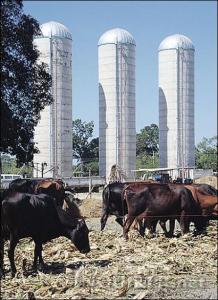Plagued by corruption
By Manny Piñol
For a country which imports 99% of its milk and dairy requirements, it comes as a surprise that the Philippine Dairy Program has not really made any progress in producing more milk for its growing population in spite of hundreds of millions poured into it over the years.
 |
| Cows graze at the seven-hectare farm in Laoac, Pangasinan. Behind are silos where food for hem are stored for ”rainy days”. RAY ZAMBRANO |
When I assumed as the Secretary of Agriculture and Fisheries following the victory of President Rody Duterte, I discovered why in spite of the hundreds of millions of pesos poured by government, including assistance from the US and New Zealand Governments, the country's dairy program hardly moved forward.
The program is rife with corruption and badly planned programs.
There was a transaction completed during the previous administration which I immediately stopped and ordered cancelled.
This involved the purchase of dairy goats from the U.S. amounting to over P160-M where one goat was priced at an incredible P170,000.
This prompted me to ask whether government was buying goats with Golden Horns.
Not only was the price scandalous. The quality of the goats brought in supposedly for genetic improvement of the local dairy goats was very poor. In fact, many of the does I saw in the centers where they were kept were simply old "working goats" used for milking rather than breeding.
The dairy cattle program fared no better. Dairy cows were brought in without a well-planned program. In fact, the last importation of at least 300 Holstein dairy cattle ended up in the hands of a private rancher instead of the dairy farmers because the government failed to identify the recipients before importing the herd.
Why do I understand all of these?
Well, for some time, I was deeply involved with goat raising. In fact, my Boers were among the best in the country with my favorite buck, Rocky, winning the National Best Boer buck honors in the early 2000.
My Anglo Nubians and La Manchas were sought after by other breeders and many of the bloodlines I had are now in the hands of dairy goat breeders in the country.
The fact is I am an inactive member of the American Dairy Goat Association (ADGA), one of the biggest and most respected association of dairy goat farmers in the world.
I promised President Duterte that there will be no corruption in the Department of Agriculture and Fisheries under my stewardship and this would mean that I will correct the wrongs in the dairy program of the department.
First, I have promised local dairy goat breeders that the Department will be buying proven materials from them which will be used in the establishment of municipal multiplier farms.
These multiplier farms which will be established in every town interested in the dairy program will serve as the learning center for prospective dairy farmers both for goat, cattle and buffalo.
I will eliminate from the program "goat merchants" who just buy goats from everywhere and supply these to the Department.
Second, I have declared that henceforth, the Department will only be importing the best breeding materials for its genetic improvement program, even if I have to do the material selection myself.
Only dairy goats and dairy cattle with genetic records and registered with respected dairy associations will be procured.
I have already met with the Ambassador of New Zealand, Israel and Argentina who all committed to support the Dairy Cattle Development Program of the country.
For outstanding genetic materials for dairy goats, I have personally sought the help of my friends in the US who are involved in dairy goat farming.
Last Tuesday, shortly after arriving from Manila, I and the DAF team took a seven-hour land trip to Klamath Falls City in Southern Oregon to visit the dairy goat farm of an American friend, Jim Clem, whose crosses of the La Mancha over Anglo Nubian breeds are producing an incredible 3.5 to 8 liters of milk daily.
Jim's does would peak with 2 to 2.5 gallons (one gallon is 3.78 liters) two to three months after birthing and would continue holding milk up to 12 to 13 months producing 1 to 1.5 gallons.
His goats produce more milk than some of the dairy cattle and Bulgarian dairy buffaloes that we have in the country.
Jim has promised to help the Department in identifying the best dairy goat materials available in the US which will then be made available to local dairy breeders in the country like Rene Almeda of Alaminos Goat Farm, Dr. Rufo Llorin of Naga City Goat Farm, Toto Albano of Davao, Mt. Carmel Baptist Goat Farm in Davao del Sur and others.
We will reform the dairy development program of the country under the leadership of President Duterte.
As Secretary of Agriculture and Fisheries, I assure the Filipino people that the Dairy Development Program of the country will no longer be a "milking cow" of the corrupt and thieves in government.

No comments:
Post a Comment